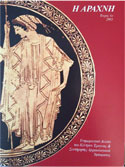Production techniques
Warp weighted loom
The majority of textiles are plain woven, a technique incorporating the simplest way the two systems involved interlock, where the weft passes over and under one warp at a time. Plain weave textiles include balanced plain weaves, with the same thread count of warps and wefts, and weft or warp faced weaves, where either the weft or warp thread count is higher. Weft-faced textiles seem to have been more common in Ancient Greece.
The absence in variety of weave types was counterbalanced by a plethora of other aspects, such as the thread diameter, the thickness of fabric, material quality and decoration, that highly influenced the final product. It has been observed that the appearance of textile with the same weave is rarely the same, but is greatly influenced by the technological characteristics mentioned above.
Apart from plain woven fabrics, more intricate ones can be executed on a warp-weighted loom: twills, where one-system threads float over the other in diagonal parallels creating characteristic diagonal and rhomboid patterns; loop weaves, producing textiles similar to contemporary towels and long-haired blankets. Finally, tapestry weave, a technique that allows for the execution of an admirable range of figurative designs.
At the same time, written sources, iconography and extant fabrics indicate the parallel use of several other techniques for textile production.
Narrow Loom
The discovery of narrow bands, such as the Late Bronze Age band from Khania, Crete and the 10th c. BC band from Lefkandi suggest the use of smaller and certainly narrower looms for the construction of small textiles. This is also illustrated in iconography with frequent depictions of narrow bands, and also mentioned in written sources. In the 4th c. BC there is even a mention of a ribbon seller in Athens.
Tablet weaving
This is a type of weaving where tablets or cards are used to create the shed through which the weft passes. The resulting fabrics are particularly narrow.
Even though fabrics created with tablet weaving have not yet been discovered in Greece, many elements of costume decoration depicted in ancient iconography indicate the eventual use of this technique as early as the Bronze Age (wall-paintings in Akrotiri, Thera). A great number of depictions of garments show narrow bands, very often at the edges, decorated with mostly geometric patterns. These patterns can easily be created with tablet weaving either simultaneously to the actual weaving, or on separate looms and later sewn onto the garments.
Sprang
Depictions of small frames in Classical iconography indicate the use of portable looms for textile production. The combination of information from these depictions with references in written sources and illustrations of hairnets that may have been made with sprang, is suggestive of the use of this technique at least during the Classical period.
Sprang is a technique that uses only one system of threads to create perforated and elastic pieces of cloth, often used as headdresses. In Greece, the only surviving piece of fabric related to sprang is a perforated construction made of linen, found in Kerameikos. The condition of the find is extremely poor, hence the method of construction has not been deciphered in detail yet. It is uncertain whether it is a sprang or a crochet technique.
Felt
Another technique is felt-making that does not require the use of a loom. Since it produces water and wind repellent fabrics, ancient writers mention it for the production of hats and shoes, as well as tents and capes. Felt hats and caps are frequently depicted in ancient iconography.


